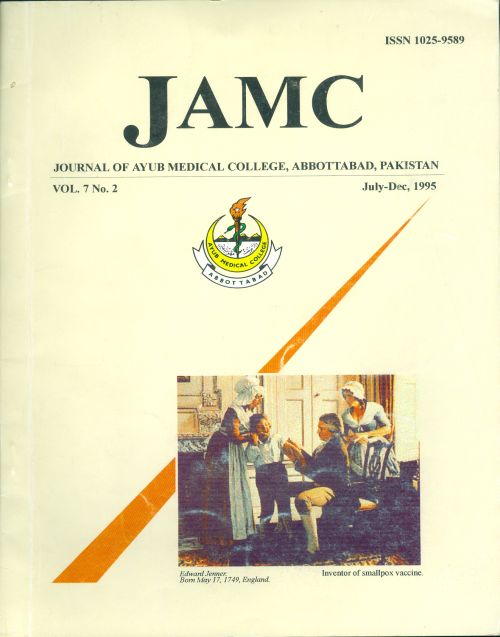PATTERN OF SEXUALLY TRANSMITTED DISEASES IN HAZARA DIVISION
Abstract
A retrospective study was done involving 185 patients with sexually transmitted diseases, the aim being toknow the pattern of sexually transmitted diseases, male to female ratio, common age groups, marital statusand sources of infection. Gonorrhoea was the most common sexually transmitted disease. There were 32cases of genital warts, 16 cases of non-gonococcal urethritis, 10 cases of genital molluscurn contagiosum, 9cases of herpes genitalis, 8 cases of syphilis, 6 cases of lymphogranuloma venereum and 2 cases of chancroid.Of 185 cases only 6 were females. Majority of the patients were between 20-40 years of age. Most of thepatients (about 64%) were married and had acquired infections from prostitutes, married women andeunuchs.References
Shah SA. Pattern of sexually transmitted diseases in
Karachi. JPAD. Vols. 2&3, Oct-Dec 1992 and Jan- Mar
Harris JRW. Recent advances in sexually transmitted
diseases. No. 2. London, Churchill Livingstone, 1981.
Thin TN. Lecture notes on sexually transmitted diseases.
London, Blackwell Scientific Publication, 1982.
Ninstum LS, Goldenring J & Carpenter S. Non- sexual
transmission of sexually transmitted diseases: an
infrequent occurrence. Paediatrics, 74: 67-76, 1984.
Issue
Section
License
Journal of Ayub Medical College, Abbottabad is an OPEN ACCESS JOURNAL which means that all content is FREELY available without charge to all users whether registered with the journal or not. The work published by J Ayub Med Coll Abbottabad is licensed and distributed under the creative commons License CC BY ND Attribution-NoDerivs. Material printed in this journal is OPEN to access, and are FREE for use in academic and research work with proper citation. J Ayub Med Coll Abbottabad accepts only original material for publication with the understanding that except for abstracts, no part of the data has been published or will be submitted for publication elsewhere before appearing in J Ayub Med Coll Abbottabad. The Editorial Board of J Ayub Med Coll Abbottabad makes every effort to ensure the accuracy and authenticity of material printed in J Ayub Med Coll Abbottabad. However, conclusions and statements expressed are views of the authors and do not reflect the opinion/policy of J Ayub Med Coll Abbottabad or the Editorial Board.
USERS are allowed to read, download, copy, distribute, print, search, or link to the full texts of the articles, or use them for any other lawful purpose, without asking prior permission from the publisher or the author. This is in accordance with the BOAI definition of open access.
AUTHORS retain the rights of free downloading/unlimited e-print of full text and sharing/disseminating the article without any restriction, by any means including twitter, scholarly collaboration networks such as ResearchGate, Academia.eu, and social media sites such as Twitter, LinkedIn, Google Scholar and any other professional or academic networking site.









